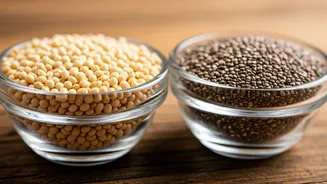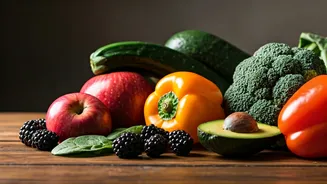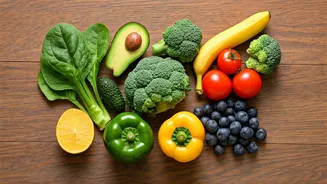Embrace Leafy Greens
Leafy green vegetables are low in carbohydrates and rich in fiber, vitamins, and minerals. Fiber slows down the absorption of sugar into the bloodstream,
which is beneficial for people with diabetes. Spinach, kale, and collard greens are excellent choices. They provide essential nutrients without significantly affecting blood sugar levels. Moreover, these vegetables are packed with antioxidants that protect against cellular damage, which can be an added benefit for those with diabetes. Preparing these greens is flexible; they can be added to salads, smoothies, or cooked as part of a meal. They can contribute to a feeling of fullness, which can help control appetite and prevent overeating, a key aspect of managing diabetes. In addition to fiber, leafy greens also contain magnesium, a mineral shown to improve insulin sensitivity.
Choose Whole Grains
Switching from refined grains to whole grains can significantly improve blood sugar control. Foods like brown rice, quinoa, and oats release glucose slowly into the bloodstream. This slower release prevents the spikes in blood sugar often associated with refined carbohydrates. Whole grains are also rich in fiber, promoting digestive health and contributing to a feeling of fullness, which can help manage weight. It's important to read labels carefully and choose products where the first ingredient listed is a whole grain. These grains offer a good mix of vitamins and minerals, unlike their refined counterparts that have many of the beneficial parts stripped away during processing. Oats, in particular, are known for their soluble fiber content, which can help lower cholesterol levels, a common concern for people with diabetes. Start your day with a bowl of oatmeal or incorporate quinoa into your lunches and dinners.
Incorporate Fatty Fish
Fatty fish, such as salmon, mackerel, and sardines, are excellent sources of omega-3 fatty acids, which can lower the risk of heart disease, a major health concern for those with diabetes. Omega-3s reduce inflammation and improve insulin sensitivity. These fish are also packed with protein, which helps maintain blood sugar stability and supports muscle mass. Protein takes longer to digest, contributing to a feeling of fullness and minimizing post-meal blood sugar surges. The American Diabetes Association recommends incorporating fish into your diet at least twice a week. When choosing fish, look for wild-caught varieties if possible, as they often have higher levels of omega-3s and fewer contaminants than farmed fish. Grilling, baking, or steaming fish are healthier ways to prepare it, avoiding the addition of unhealthy fats.
Embrace Nuts and Seeds
Nuts and seeds are excellent snacks for people with diabetes. They are packed with healthy fats, fiber, and protein. These components work together to slow down the absorption of sugar and provide sustained energy. Nuts and seeds can help manage blood sugar levels and improve cardiovascular health. Almonds, walnuts, chia seeds, and flaxseeds are all great options. They offer a satisfying crunch and can be easily added to meals or enjoyed as a snack between meals. However, it's essential to consume nuts and seeds in moderation due to their high-calorie content. A handful or a small portion is usually sufficient. Nuts and seeds also contain various vitamins and minerals that can support overall health and potentially counteract some of the complications associated with diabetes. Consider adding a tablespoon of chia seeds to your morning smoothie or sprinkling some walnuts on your salad.
Select Citrus Fruits
Citrus fruits, like oranges, grapefruits, and lemons, are rich in vitamin C and fiber, making them a suitable addition to a diabetes-friendly diet. Their low glycemic index (GI) means they have a minimal impact on blood sugar levels. The high fiber content further supports healthy blood sugar control. Moreover, citrus fruits contain antioxidants that can help protect against cell damage. These fruits can be consumed fresh, squeezed into drinks, or added to salads. However, portion control is crucial, especially regarding fruit juice, as it lacks the fiber of whole fruit and can cause a more rapid rise in blood sugar. Eating whole citrus fruits also offers additional fiber, helping to promote digestive health. Consuming citrus fruits can be a refreshing and flavorful way to meet your daily fruit intake, complementing a balanced diabetes diet.
Integrate Berries Regularly
Berries are a fantastic choice for people with diabetes due to their low glycemic index and high antioxidant content. Berries such as strawberries, blueberries, and raspberries have plenty of fiber, vitamins, and antioxidants. The fiber helps slow down sugar absorption, which is vital for blood sugar management. Antioxidants protect the body from damage caused by free radicals, potentially reducing diabetes complications. Berries can be consumed fresh, frozen, or added to smoothies or yogurt. They offer natural sweetness and add variety to your diet. The low carbohydrate content of berries makes them an excellent alternative to higher-sugar fruits. Enjoying berries in moderation as part of a balanced diet provides flavor, nutrients, and potential health advantages, particularly for managing diabetes.
Use Healthy Fats
Including healthy fats like olive oil, avocado, and nuts in your diet is vital for managing diabetes. These fats help stabilize blood sugar levels and promote overall health. Olive oil, in particular, has been linked to improved insulin sensitivity. Avocados are rich in monounsaturated fats, and they also provide fiber, which aids in blood sugar control. These healthy fats help with satiety and can also improve heart health, a vital factor for people with diabetes. Using olive oil for cooking or as a salad dressing, and adding avocado to your meals can be simple ways to incorporate these beneficial fats. Be mindful of portion sizes, as healthy fats are calorie-dense. Maintaining a balanced intake of healthy fats can complement a diet focused on managing type 2 diabetes by improving blood sugar management and enhancing overall well-being.













